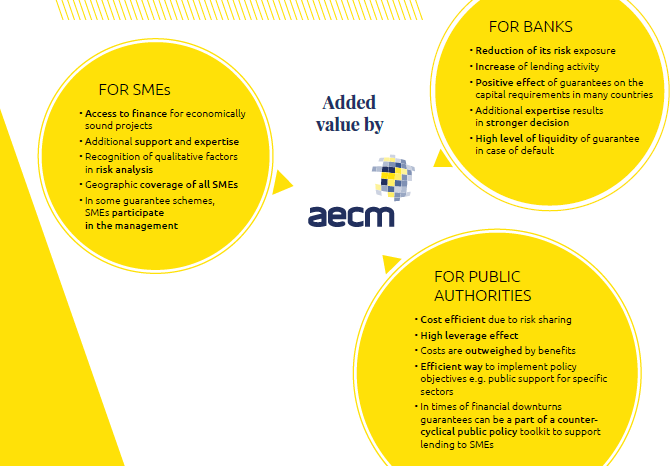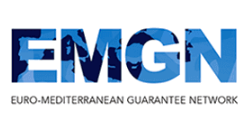Guarantee Institutions
What are Guarantee Institutions?
Very often, SMEs that have economically sound investment projects, but do not dispose of sufficient collateral, cannot get access to credit finance, or only insufficient funding.
A guarantee provided by a guarantee society on behalf of the SME to the bank replaces this missing collateral and enables the bank to grant the loan. In essence, the guarantee is a financial commitment by the guarantee society to repay up to a certain percentage of the loan to the financial institution in case the SME customer should not be able to honour his payments.
The guarantee usually does not cover more than 80% of the bank loan, leaving 20% of the risk with the lender. The SME remains liable for the loan.
The SME customer usually pays a once-off processing fee and an annual guarantee fee, which are variable from guarantee institution to guarantee institution.
To know more on how a guarantee works and what AECM and its members do to support SMEs in Europe watch the following video for more information: https://www.youtube.com/watch?v=0jUIKO9awnY
For more information on the terms and conditions of the guarantee institutions in the different countries, please consult the section of the AECM member organisationsGiven the importance of SMEs in the European economy and their difficulties in accessing loan finance, guarantee organisations have been set up in nearly all EU Member States as well as Turkey. They are active as non-profit organisations at national, regional or local level. Four main typologies exist: Mutual Guarantee Societies, other types of Private Guarantee Societies, Public guarantee institutions and Public-Private Partnership initiatives. The specific choice for one or the other model reflects the economic and legal frameworks of the respective countries.
Mutual Guarantee Societies are private guarantee institutions created by beneficiary SMEs. They typically have a cooperative or mutual statute. This means that the MGS’ capital is provided directly by the SMEs that apply for a loan guarantee in form of cooperative or mutual shares. Each members has an equal voting right and participates in electing the General Assembly and Board of Directors. The Mutual Guarantee Societies are usually run by entrepreneurs, bringing an SME perspective to the risk asessment process.
Other types of Private Guarantee Societies are founded as initiatives by representative organisations of the private sector (Chambers of Commerce or Crafts, Business Federations, Banking organisations, etc.). They have a joint-stock company statute, foundation statute or other. The capital is provided by the private shareholders.
Public Guarantee Institutions have been set up by public authorities in a number of countries. They are legally independent entities and can chose from a variety of statutes, e.g. development bank, development fund, etc. They are entirely funded and run by public shareholders. They implement public SME support policy and either guarantee SMEs directly or provide counter-guarantees to private Guarantee Societies.
In some cases, Guarantee societies have chosen a Public-private partnership model, where the public shareholder usually holds a minority stake.
Independent from their legal statutes, a great majority of AECM members have a statute of financial intermediary or a mono-line banking lisense. They are thus subject to financial supervision by their national authorities.
Added value of Guarantee schemes for SMEs and Banks
Guarantee schemes provide benefits to beneficiary SMEs, their banks and public authorities.

Public support and counter-guarantees for guarantee schemes
Aside from the public guarantee schemes, that are 100% owned by the public authorities, private and mutual guarantee schemes also usually benefit from support measures.
They received either direct funding for their own funds, allowing it to issue more guarantees, or their guarantees are counter-guaranteed by the state or the regions, which means that the losses from a credit default are split between the bank, the guarantee scheme and the public authorities. The public support for guarantees has the following rationales:
1. Multiplier effect / Cost efficiency
The guarantee instrument is characterised by a high leverage effect (guarantee volume over own funds), resulting in a high volume of guarantees and even higher volume of credits accessed. As a consequence, the instrument is not only very cost effective from a promotional point of view, but also allows addressing a larger population of SMEs for the same amount of support funds.
As an example, € 1 of own funds with a leverage of 10 and e.g. a 50% coverage ratio, results in € 10 of guarantees, € 20 of bank loans and an even higher amount of final investment.
2. Added value of guarantees for public authorities
Aside from the micro-economic impact for the final beneficiaries, i.e. the SMEs, guarantees also provide public authorities with budgetary benefits that exceed the costs of the support measures.
As an example, these benefits have been analysed for Germany over the period from 1996 2002 by a study conducted by the University of Trier in 2006: http://www.inmit.de/download/studie_buergschaftsbanken_engl.pdf
The study found that for Germany, the activity of the guarantee banks had resulted on average in:
- An increase of GDP by € 3,2 billion
- Employment creation of 12.900 new jobs p.a
- Reduction of unemployed by 9.100 per year
- Increase of fiscal receipts by € 720 million (from taxes on goods, income and capital). After deducting default payments, the net balance for the German state came out € 670 million higher than without guarantees.
The above-mentioned overall positive benefits from an economic and social development policy perspective have lead Member States in Europe as well as the European Institutions to recognise the added value of guarantees and to support guarantee schemes of differing typologies.
How to apply for a guarantee
Guarantee institutions usually market their guarantees through the network of partner banks. There are two ways the guarantee is issued through the banks:
Guarantee approach
The SME applies to the guarantee institution via the bank. The guarantee institution performs a detailed analysis of the project’s qualitative potential. On a positive assessment, guarantee is issued to the bank on behalf of the SME.
Portfolio guarantee approach
The guarantee institution provides the respective partner banks / banking networks with a global guarantee amount. The banks can call on this amount without having to obtain the individual approval by the guarantee scheme. The agreement between the banks and the guarantee schemes usually fix a loss cap rate as well as reporting requirements and inspection rights. The global amount is renegotiated regularly on the basis of the used volumes and the respect of the contractual obligations.
An SME which does not have sufficient collateral to obtain a loan should either ask its bank on how to apply for a guarantee or contact directly the guarantee scheme in its respective country.
For contact details, please consult the AECM member section.


